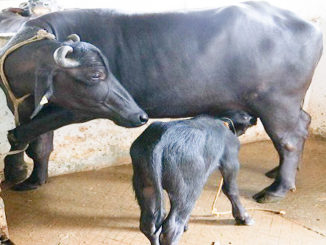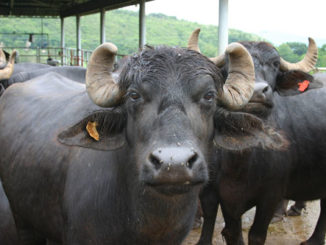To refresh the knowledge of the veterinarian for a methodical approach for diagnosing and therapeutic management of the cases of infertility, which in present scenario has gained its importance in majority due to managemental problems and for the requirement of a right approach for diagnosing cases of infertility, this article is prepared.
Objectives of Fertility Control Program
- To investigate and determine cases of infertility and
- Management through maintenance of optimal fertility
Achievement of these goals are necessary to run a farm efficiently and profitably. To maintain the optimal level of fertility requires the active collaboration of the persons looking after the herds, the owner of the farm and the veterinarian.
All these persons should have a positive commitment to ensure that the system functions effectively.
Expectation of Normal Fertility
A normal expectation of fertility is recognized first by failure to return to estrus or non-return rate. Also, it is a well-recognized fact that it female with normal genital organs inseminated or served with normal fertile semen at correct time may fail to conceive.
In U K. the non-return rate to A.I or natural service is nearly 80%. However, calving rate to single insemination is 55%. The reason behind this discrepancy (80% vs 55%) could be because of any of the following factors:
- Cows coming to estrus not observed properly
- Cows which return to estrus are culled and data not recorded
- Estrus should not be detected properly
- Persistant CL
- Luteal cyst
- Some of the animals may have aborted
- Embryonic deaths
Embryonic Losses
It has been an established fact that the incidence of embryonic and fetal death in all domestic species ranges between 20 to 50% (Corner’s, 1923). According to Bishop (1964), to some extent embryonic loss is a general feature of mammalian reproduction as it allows the undesirable genetic material at biological cost. However, the rest of losses are assigned to inherent genetic abnormalities (Land et al., 1981 &1983) and asynchrony between dam and embryo (Wilmut, et al., 1985). In cows, if an embryo dies before 13 days of age, animal has a normal interoestus interval but if it dies after day 13 than the interoestrus period is prolonged (more than the length of average estrus cycle i.e. 18-24 days). Thus before day 13 it is impossible to differentiate by observing the occurrence of estrus between embryonic death and fertilization failure.
It has been reported that maximum loss to embryo occurs between days 20 to 40 of gestation. Barrelt et al (1948) conducted a survey on 4286 cows to discover the embryonic loss in different stage of gestation and reported the following findings:
| Embryonic loss | Days of gestation |
| 14.90% | 30-60 days |
| 5.50% | 60-90 days |
| 2.80% | 90-120 days |
There are various other examples which indicate that embryonic deaths took place in early stage of gestation
| S.No. | Category of animal | Gestation Stage | Fertilization failure | Embryonic death | References |
| 1 | First service heifers | 35 days | 3.40% | 10.50% | Bearden et al., 1956 |
| 2 | Repeat breeder heifers | 35 days | 40.80% | 28.70% | Tanabe and Almquist, 1953 |
| 3 | Repeat breeder cows | 35 days | 39.70% | 39.20% | Tanabe and Casida, 1949 |
| 4 | Repeat breeder Cows | 35 days | 29% | 36% | Ayalon, 1978 |
| 5 | Normal fertile cows | 35 days | 15% | 15% | Boyd et al., 1969 |
| 6 | Normal fertile cows | 35 days | 17% | 14% | Ayalon, 1978 |
Two factors are responsible for embryonic deaths;
- Genetic factor and
- Environmental factors.
Amongst the genetic factors chromosomal abnormalities and mutagenic induced changes in DNA are the main. A number of sources can acts as a mutagens and example of such mutagens in our day to day biological works are various superovulatory hormones, culture media, serum, ultraviolet light, DNA bindings dyes, radioactivity and ethylene oxide gas.
The important environmental factors are:
1. Nutritional deficiency or excess influence the level ol embryonic death particularly at the time of cleavage (Gustafson et al. 1985). It has been seen that beef heifers when kept on low energy dietary regimen has resulted in embryonic death (Spitzer et al, 1978) and fertilization Failure (Hill et al.,1970).
2. Age of the mother too has its effect as increased interoestrus period has been observed in older animals (Boyd and Reed, 1961), moreover, animals having four or more lactation periods are reported to be having more cases of embryonic deaths (Ball.1978).
3. High enviromental temperature depresses fertility and this is important for the first 4-6 days (Wiersma and Stott, 1969) or the first 35 days (Williams, 1962) after service.
4. Hormonal asynchrony and imbalance is also said to be responsible for embryonic death and one of the best proof for this is the results obtained from the ETT where an asynchrony of more than 24 hrs between the donor and recipient results in embryonic loss (Rowson et al., 1969 and Newcombe and Rowson, 1975).
5. Uterine envirenment has also its effect and this has also been seen with the experiment on ETT where many donors who earlier were a problematic breeder after undergone the process of superovulation and uterine flushing conceived. Also, change in composition of uterine flushing has been reported between repeat breeder and normal cows.
Approach for investigating individual infertile cow
Infertile cows can be diagnosed by going through a complete investigation of
- Collection of breeding history
- Clinical examination of the animal and
- By performing certain diagnostic tests.
1. Breeding History
Before a detailed gynaecological examination it is important to collect detailed and accurate breeding history of the cow. The history should includes:
- Age of the animal
- Parity (as certain condition can be exclude in nullipara)
- Date of last calving (including occurrence of dystocia, ROP, puerperal infections etc.)
- Date of observed estrus since calving.
- Presence of any abnormal discharge
- Number and dates of services or insemination
- Dates of observed estrus since service or A.I
- Previous fertility records including
(1) calving conception intervals and (2) service per conception - Details of feeding, management and milk yield
- Details of health including
(1) milk fever (2) ketosis and (3) mastitis - Fertility details of other cows or heifers in the herd or group
2. Clinical Examination
- General examination – which should include general body condition and live weight
- Detail examination of genital system should include
- Inspection of vulva, perineum and vestibule for discharge and evidence of current or healed lesions.
- Examine base of tail, back and flank for rub marks or hoof marks
- Explore vagina with speculum or hand for examination of mucus.
- Per rectal palpation of cervix for position in relation to pelvic brim and for size
- Per rectal palpation of uterus for texture, tone, mobility, absence of adhesion and pregnancy
- Palpation of uterine tube for indurations or increased size etc.
- Palpation of ovarian bursa for evidence of ovaro-bursal adhesion (OB A)
- Palpation of ovaries for position, mobility, size and activity if any
3. Diagnostic Tests
- Single test for progesterone hormone in the plasma or milk. In plasma a concentration of 4-6 ng/ ml or in milk of 12-18 ng/ml gives an indication of luteal tissue or luteal cyst or persistent corpus luteum (PCL)
- Serological tests for mucus agglutination or fluorescent antibody tests should be conducted for Campylobacter fetus.
- PSP (Phenosulphothalene dye) test should be conducted for patency of fallopian tube.
- Bacterial swabbing, culture and endometrial biopsy are of limited importance.
How to explore possibility of infertility on the basis of signs
(A) No observed oestrus
Do rectal examination or diagnostic utlrasonography for the presence of —
- Pregnancy
- In a doubtful case of pregnancy re-examine at a later date
- If non-pregnant go for examination of ovaries
Examination of ovaries
- Absence of ovaries: should be seen only in heifers and in case it is absent animal is to be culled.
- Small inactive ovaries: if ovaries are small, narrow, spindle shaped and functionless and the animal is a heifer, it is suggestive of
(a) a case of delayed puberty or
(b) a case of ovarian hypoplasia or
(c) a case of free-martinism.
If age and body weight of the animal coincide to the standard for puberty, no treatment is to be initiated and cycle starts eventually. For the other two conditions culling is recommended.
If ovaries are flattened, smooth, small and active, condition is one of a true anoestrus. Confirm with milk progesterone assay at 10 days intervals. Check history, which may be of high milk yielder, have a suckling calf, inadequate energy intake, intercurrent disease, post-partum weight loss and trace element deficiency.
Suggested treatment: Check feeding and assess body condition, improve if deficiency is present
Can insert PRID for 9 to 12 days and estrus can be expected after several days of its withdrawal
OR can go for Gn-RH injection with occurrence of estrus after 1 to 3 weeks
OR ear implant (Creaster, norgestomate) for 12 days and on the day of removal inject eCG @ 400- 600 IU
- Ovary containing one or more corpora lutea: Situation could be
May be animal is pregnant: in doubtful case re-examine
Non-detected estrus: solution includes (1) improve heat detection with increased frequency of observation, (2) use of estrus detection aids (3) use of PGs and fixed time A.I
Sub estrus or silent heat: history will revealed of recent calving, solution for such cases should include treatment with PGs
PCL: condition could be of (1) pyometra (2) chronic endometritis (3) mummified fetus or (4) rarely a non-specific infection. Solution for all such cases should be use of PGs
- Small active ovaries: The animal may be having a small follicle or is having a regressing CL or could be a case of recent ovulation. In such case check for uterine tone, inspect vulva for presence of clear mucus or re-examination at 10 days apart could reveal a CL
- Ovarian cysts (Luteal cysts): In such cases
One or both ovaries may be enlarged
Have fluctuating fluid filled structure of > 2.5 cms in exotic breeds and> 1.7 cms
Thick walled structure
Confirm the condition by rectal palpation at 10 days apart or with milk progesterone assay or by the use of ultrasonography
Treatment in this case be use of PGs
(B) Prolonged inter-oestrus interval
Do examination of ovaries and genital tract.
Ovaries : if ovaries are normal infertility could be due to
- Non-detected estrus: check interoestrus interval and if it is between 36-48 days it indicate missed heat. If irregular interval is not a multiple of mean estrus cycle length the cause is incorrect identification of estrus. If history suggest that the problem is with a large number of animals it suggest poor estrus detection rate. Solution for such problem is to treat animal with PGs if CL is detected. Animal is to be inseminated following induced estrus or improvement in estrus detection rate is needed.
- Embryonic death: In such cases the interoestrs interval is unlikely to be a multiple of mean estrus cycle length (18-24 days) but could be of 35 or 46 days. If it happens with individual animal it is of no significance but if it is a case with large population having a history of natural service than eliminate specific pathogens.
(C) Regular return to oestrus (Repeat Breeder or cyclic non breeder)
Examine for ovary and genital tract for presence of gross abnormalities such as severe adhesion or uterine infection. This happens either due to failure of fertilization or embryonic death before day 13 of estrus cycle. Possibilities for repeat breeding could be because of
- Infertile bull
- Incorrect time of service /A.I : If it is problem of large population suggest fixed time A.I after PGs injection.
- Nutrition deficiency or excesses: check diet
- Occluded fallopian tube : go for PSP test
- Anatomical defects : if nullipara checks for segmental aplasia. If condition is with parous animal check for OBA
- Endometritis : if clinical signs are present it is easy to treat. In sub clinical cases, go for endometrial biopsy. In suspected cases for endometritis treat with antibiotic or PG to shorten luteal phase
- Delayed ovulation: diagnosis difficult however can for repeated examination after 24 to 48 hrs intervals OR treat with HCG or Gn-RH at the time of examination OR can for repeated examination
- Anovulation: go for rectal examination of ovaries after 7 to 10 days post oetrus to demonstrate failure of estrus with no CL. Treat such cases with Gn-RH Or HCG at the time of A.I
- Luteal deficiency: If no other cause is detected can go for treatment with luteotrophic agents like HCG for 2-3days post insemination or at mid cycle for formation of accessory CL OR with Gn-RH 12 to 13 days after insemination.
(D) Short inter-oestrus interval
If this is suspected possibility could be :
A.I at wrong time due to incorrect estrus detection: Check if the number of animal having similar history is more, advice for improved estrus detection.
May have problem with individual animals: Check for signs of nymphomania in which case ovarian examination could reveal presence of fluid filled cyst. On confirmation go for treatment with Gn-RH, HCG or PRID.
| The content of the articles are accurate and true to the best of the author’s knowledge. It is not meant to substitute for diagnosis, prognosis, treatment, prescription, or formal and individualized advice from a veterinary medical professional. Animals exhibiting signs and symptoms of distress should be seen by a veterinarian immediately. |







Be the first to comment